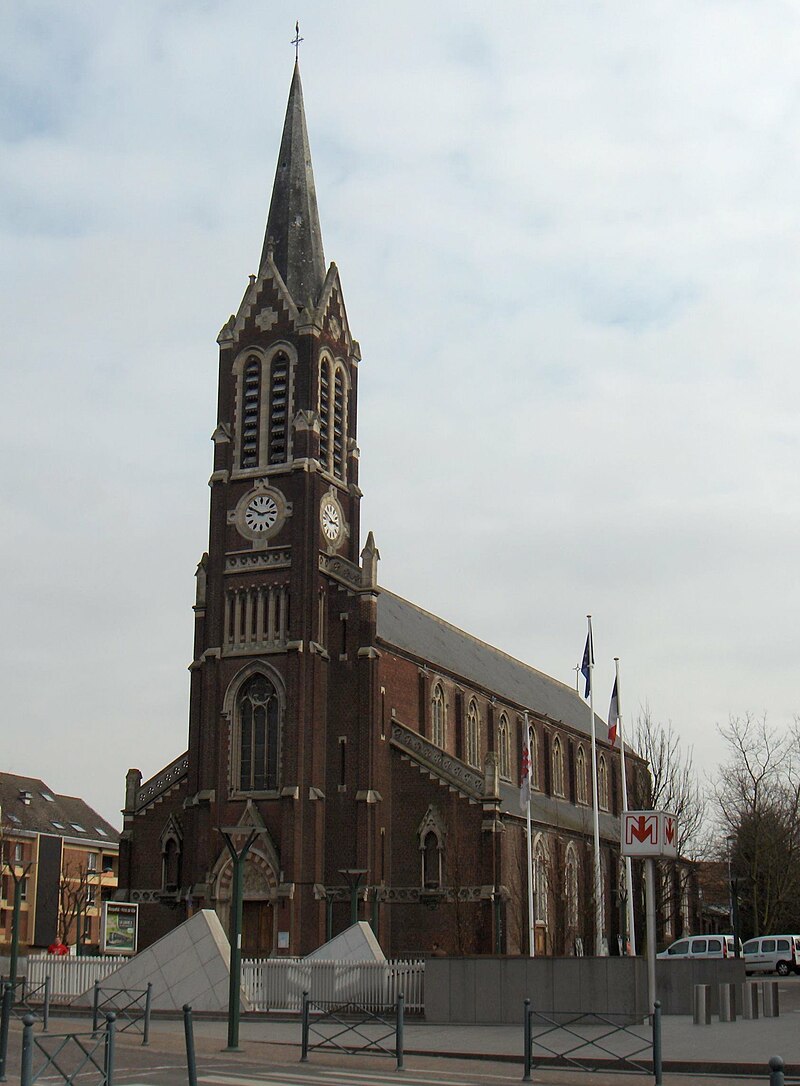This post features the pipe organ of Wasquehal stamp. Of all the types of musical-themed stamps, the rarest are those that feature a musical instrument. Not those that show a kind of instrument – a piano, a violin, a post horn, etc., but a stamp that depicts or commemorates a specific instrument. Of these, stamps with organs are the most popular. One of my favorites is a stamp celebrating an organ in the small town of Wasquehal, France.
The Church
I had never heard of the town before I got the stamp, and Wasquehal doesn’t exactly seem like a French name. The town of about twenty-thousand individuals is on the north of France, near the border with Belgium, and the name itself is of Flemish origins.

Photo by Friedrich Tellberg — Travail personnel, Domaine public
The organ is in the church of Saint Nicolas. Its location has been home to a church since 1252. The original structure was burned down in 1482 and a second church erected in 1511. The current church was consecrated in 1901. You can read more on the church’s website.
The Organ Builder
Gérald Guillemin (b. 1948) built the organ, based on nineteenth-century instruments. Guillemin apprenticed with the organ builder Alfred Kern in Strasbourg before establishing his own workshop in 1976 in Malaucène in the southeast of France. His instruments follow historical models such as the baroque instruments of German builder Gottfried Silbermann. Guillemin is also the author of a book about organs in northern Europe.
Guillemin has organs in churches and cathedrals throughout France. This includes organs in the cathedral of Saint-Étienne in Agde, the church of Sainte-Thérèse in Montpellier, St. Odile’s church in Belfort, and the church of Saint Vincent in Mérignac.
The Organ

featuring the Organ from the church of Église Saint Nicolas, France, 1991. Scott 2252
The church of St. Nicolas entry on French Wikipedia lists the following specific information about the organ can be found on the French Wikipedia. The Guillemin organ has three keyboards of 56 keys, a 30 note pedal board, and has 2800 pipes. It is a tracker mechanical action. The instrument has become well known due to its use in the St. Omer-Wasquehal international organ competition and through recordings, perhaps most notably Olivier Vernet’s performance of the complete organ works of Dietrich Buxtehude.
The disposition of the organ is as follows:
| I – Rückpositiv | II – Hauptwerk | III – Oberwerk | Pedal |
| Viola di gamba 8 | Quintaden 16 | Main 8 | Main 16 |
| Gedackt 8 | Main 8 | Gedackt 8 | Octav 8 |
| Octave 4 | Quintaden 8 | Rohrflöte 4 | Octav 4 |
| Rohrflöte 4 | Rohrflöte 8 | Nasat 2 2/3 | Nachthorn 2 |
| Waldflöte 2 | Octave 4 | Octava 2 | Mixtur VI |
| Octava 2 | Spitzflöte 4 | Tertia 1 3/5 | Posaune 32 |
| Sesquialter II | Quinta 2 2/3 | Quinta 1 1/3 | Posaune 16 |
| Mixtur IV-V-VI | Octava 2 | Whistle 1 | Trumpet 8 |
| Krummhorn 8 | Mixtur VI | Cimbel III | Clarin 4 |
| Cornet V | Vox humana 8 | ||
| Fagott 16 | |||
| Trumpet 8 |
Drawer couplings I / II and III / II; tirasses II, III Tremblants I, II, III. Agreement: The 440 at 15 ° C. Kirnberger III temperament. Pressures of 78mm in the manuals and 85mm in the pedal.
The organ is regularly in use for church servies, concerts, and recordings, like the one that follows.


